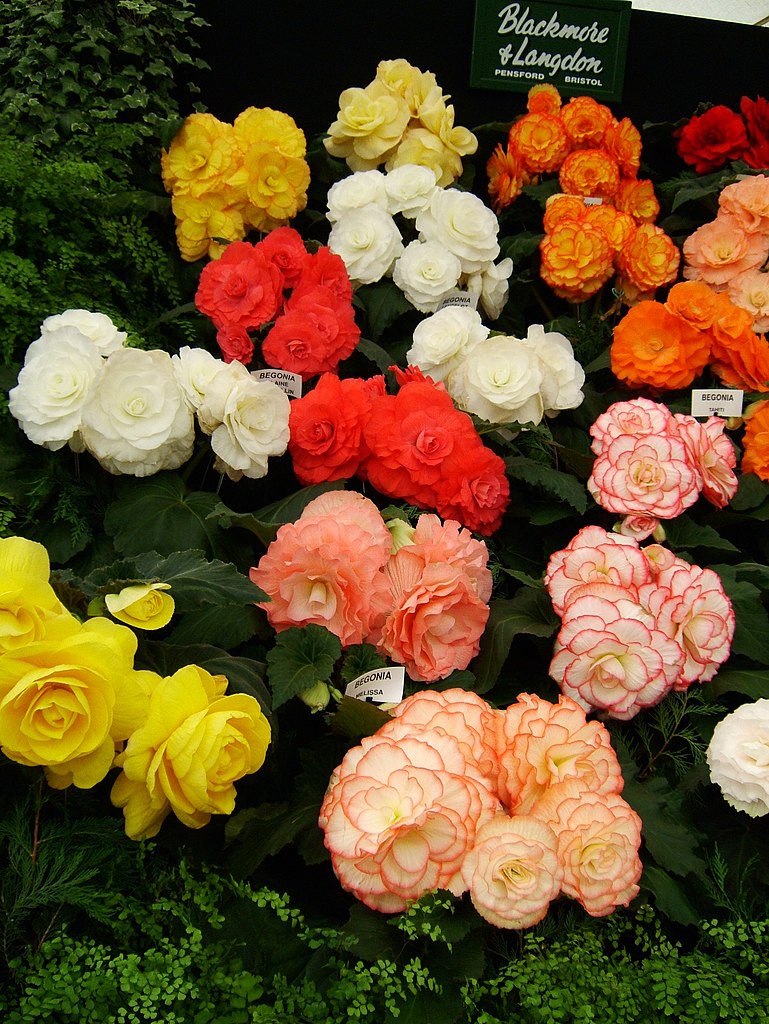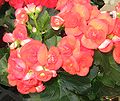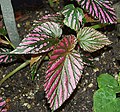| Begonia | |
|---|---|
 |
|
| Begonia cultivars | |
| Scientific classification |
|
| Kingdom: | Plantae |
| clade: | Angiosperms |
| clade: | Eudicots |
| clade: | Rosids |
| Order: | Cucurbitales |
| Family: | Begoniaceae |
| Genus: | Begonia L. |
| Species Click here to see text below |
|
Begonia is a genus in the flowering plant family Begoniaceae and is a perennial. The only other members of the family Begoniaceae are Hillebrandia, a genus with a single species in the Hawaiian Islands, and the genus Symbegonia which was annexed to Begonia in 2003, as molecular phylogenies had shown it to be derived from within that genus. “Begonia” is the common name as well as the generic name for all members of the genus.
Begonia is the world’s sixth largest plant genus, which has recently exceeded 2,000 species since researchers examined historic records and new collections. Coined by Charles Plumier, a French patron of botany, the genus name honours Michel Bégon, a former governor of the French colony of Haiti. It was later adopted by Carl Linnaeus, the father of modern taxonomy who formalised binomial nomenclature. As a member of the order Curcurbitales, begonias are relatively closely related to such food crops as pumpkins/squash, gourds, cucumbers and melons.
Contents |
| Wikispecies has information related to: Begonia |
Description
Estimated to be around 1,800 species, Begonia is the sixth largest angiosperm genus.[1] The species are terrestrial (sometimes epiphytic) herbs or undershrubs and occur in subtropical and tropical moist climates, in South and Central America, Africa and southern Asia. Terrestrial species in the wild are commonly upright-stemmed, rhizomatous or tuberous. The plants are monoecious, with unisexual male and female flowers occurring separately on the same plant, the male containing numerous stamens, the female having a large inferior ovary and two to four branched or twisted stigmas. In most species the fruit is a winged capsule containing numerous minute seeds, although baccate fruits are also known. The leaves, which are often large and variously marked or variegated, are usually asymmetric (unequal-sided). Some species are commonly grown indoors as ornamental houseplants in cooler climates. In warmer climates, some species are cultivated outside in summertime for their bright colourful flowers, which have sepals but no petals.
Nomenclature
The nomenclature of begonias can be very complex and confusing. The term Picotee refers to an edging on the petals that is in contrast to the colour of the main petal, if the colours blend. If they do not, then the term Marginata is used, but sometimes these terms are used simultaneously.[2] Non-Stop refers to a Camellia tuberous hybrid that under certain conditions will bloom ‘non-stop’ all year round.
Many species and innumerable hybrids and cultivars are cultivated for their sometimes showy flowers of white, pink, scarlet or yellow colour and often attractively marked leaves. The genus is unusual in that species throughout the genus, even those coming from different continents, can frequently be hybridized with each other, and this has led to an enormous number of cultivars. The American Begonia Society classifies begonias into eight major groups below. Click any group from the following list to access all posts corresponding to the group:
- cane-like
- shrub-like
- tuberous
- rhizomatous
- semperflorens (or wax begonias)
- rex
- trailing-scandent
- thick-stemmed
For the most part these groups do not correspond to any formal taxonomic groupings or phylogeny, and many species and hybrids have characteristics of more than one group, or do not fit well in any of them.
Binomial terms such as Begonia grandiflora, Begonia multiflora and Begonia pendula do not refer to accepted species, but rather varieties of tuberous begonias.[3]
Cultivation
The different groups of begonias have different cultural requirements but most species come from tropical regions and therefore they and their hybrids require warm temperatures. Most are forest understory plants and require bright shade; few will tolerate full sun, especially in warmer climates. In general, begonias require a well-drained growing medium that is neither constantly wet nor allowed to dry out completely. Many begonias will grow and flower year-round except for tuberous begonias, which usually have a dormant period, during which the tubers can be stored in a cool and dry place. Begonias of the semperflorens group (or wax begonias) are frequently grown as bedding plants outdoors. A recent group of hybrids derived from this group is marketed as “Dragonwing Begonias”; they are much larger both in leaf and in flower. Tuberous begonias are frequently used as container plants. Although most begonia species are tropical or subtropical in origin, the Chinese species B. grandis is hardy to USDA hardiness zone 6 and is commonly known as the “hardy begonia”. Most begonias can be grown outdoors year-round in subtropical or tropical climates, but those grown in temperate climates are treated as annuals, or as house or greenhouse plants.
Most begonias are easily propagated by division or from stem cuttings. In addition, many can be propagated from leaf cuttings or even sections of leaves, particularly the members of the rhizomatous and rex groups.
Popular Culture
Kimjongilia is a flower named after the late North Korean leader Kim Jong-il. It is a hybrid cultivar of tuberous begonia, registered as Begonia × tuberhybrida ‘Kimjongilhwa’. When Kim Jong-il died in December 2011 the flower was used to adorn his corpse for public display. Despite its name, the Kimjongilia is not the official national flower of North Korea, which is the Magnolia sieboldii.
The Grateful Dead wrote the popular song “Scarlet Begonias“. The lyrics were written by Robert Hunter and the music by Jerry Garcia. The live debut of “Scarlet Begonias” came on March 23, 1974 at the Cow Palace in Daly City, California. The song begins in Grosvenor Square in London and also references “Tea for Two” from No, No, Nanette by Irving Caesar and Vincent Youmans. The recording first appears on the 1974 release From the Mars Hotel. When “Fire on the Mountain” was incorporated into the band’s repertoire in 1977, “Scarlet Begonias” would often be paired with it when played live, resulting in what would be nicknamed “Scarlet > Fire”.
A contemporary American artist from San Francisco, Begonia Blossom Herbert is “a painter, photographer, graphic designer, writer and on occasion … playing the drums, singing or strumming the guitar.”
In the 1993 American comedy Mrs Doubtfire, a goat eats a begonia belonging to Miranda Hillard (played by Sally Field) during her son’s birthday party.
Most begonias are sour to the taste, and some people in certain areas eat them. Consuming begonias is safe in small amounts but potentially toxic in large quantities due to the prevalence of oxalic acid in the tissues. Those who are interested in treating begonias as food may read the post entitled “Edible Begonias” to learn more about begonias as edible plants that have been grown around the world both as food and as ornamentals.
Species and Cultivars
Species
- Begonia acerifolia
- Begonia acetosa Vell.
- Begonia adpressa
- Begonia aequatorialis
- Begonia aequilateralis
- Begonia aeranthos
- Begonia albo-picta W.Bull
- Begonia argenteo-guttata
- Begonia asympeltata
- Begonia auriculata Hook.
- Begonia bataiensis Kiew
- Begonia boliviensis
- Begonia bonus-henricus
- Begonia bowerae (“boweri”) Ziesenh.
- Begonia brandbygeana
- Begonia brevicyma C.DC.
- Begonia broussonetiifolia A.DC.
- Begonia cardiocarpa Liebm.
- Begonia carletonii Standl.
- Begonia carpinifolia Liebm.
- Begonia cavaleriei
- Begonia coccinea
- Begonia compacticaulis
- Begonia conchifolia A. Dietr.
- Begonia consobrina
- Begonia convallariodora C. DC.
- Begonia cooperi C. DC.
- Begonia copeyana C. DC.
- Begonia corredorana C. DC.
- Begonia cucullata var. cucullata Willd.
- Begonia davisii Hook. f.
- Begonia dentatobracteata
- Begonia dichroa
- Begonia dodsonii
- Begonia dregei
- Begonia duncan-thomasii
- Begonia eiromischa Ridl.
- Begonia estrellensis C. DC.
- Begonia exalata
- Begonia fischeri Schrank
- Begonia foliosa Kunth
- Begonia foliosa var. miniata (syn. Begonia fuchsioides Hook.)
- Begonia froebelii
- Begonia furfuracea
- Begonia fusicarpa Irmsch.
- Begonia geminiflora
- Begonia glabra Aubl.
- Begonia goegoensis Br. N.E.
- Begonia grandiflora Knowles & Westc. (syn. Begonia octopetala L’Hér.)[4]
- Begonia grandis Dryand.
- Begonia guaduensis Kunth
- Begonia hainanensis
- Begonia harlingii
- Begonia hemsleyana
- Begonia heracleifolia Cham. & Schltdl.
- Begonia heydei C. DC.
- Begonia hirsuta Aubl.
- Begonia hitchcockii
- Begonia holmnielseniana
- Begonia ignea (Klotzsch) Warsz. ex A. D.C.
- Begonia imperialis Lem.
- Begonia involucrata Liebm.
- Begonia listida
- Begonia ludwigii
- Begonia lugonis
- Begonia macrocarpa Warb.
- Begonia maculata
- Begonia mannii Hook.f.
- Begonia masoniana
- Begonia metallica
- Begonia multinervia Liebm.
- Begonia napoensis
- Begonia natalensis
- Begonia nelumbiifolia Schltdl. & Cham.
- Begonia neoharlingii
- Begonia oaxacana A. DC.
- Begonia obliqua
- Begonia octopetala L’Héritier
- Begonia oellgaardii
- Begonia oxyanthera
- Begonia oxyloba Welw. ex Hook.f.
- Begonia palmata
- Begonia parcifolia
- Begonia parviflora Poepp. & Endl.
- Begonia pearcei
- Begonia pectennervia
- Begonia pedatifida
- Begonia pelargoniiflora
- Begonia peltatifolia
- Begonia plebeja Liebm.
- Begonia preussii
- Begonia pseudoviola
- Begonia quaternata L. B. Sm. & B. G. Schub.
- Begonia rajah Ridl.
- Begonia rex Putz.
- Begonia roxburghii
- Begonia salaziensis
- Begonia schaeferi
- Begonia scharffii Hook.
- Begonia schmidtiana Regel
- Begonia secunda
- Begonia seemanniana A. DC.
- Begonia semhaensis
- Begonia semiovata Liebm.
- Begonia sericoneura Liebm.
- Begonia serotina
- Begonia socotrana
- Begonia sodiroi
- Begonia sparreana
- Begonia strigillosa A. Dietr.
- Begonia sutherlandii Hook.f.
- Begonia tetrandra
- Begonia tiger
- Begonia tonduzii C. DC.
- Begonia triramosa
- Begonia tropaeolifolia
- Begonia truncicola
- Begonia udisilvestris C. DC.
- Begonia urophylla Hook.
- Begonia urticae L. f.
- Begonia valvata
- Begonia veitchii
- Begonia venosa Skan.
- Begonia vestita C. DC.
- Begonia xerophyta
- Begonia ynesiae

Cultivars and Cultivar Groups
- Angel wing begonia (hybrid)
- Begonia ‘Immense’
- Begonia × sedenii
- Begonia × semperflorens-cultorum hort.
- Begonia × tuberhybrida Voss – Tuberous begonias (cultivar group)


Display of tuberous begonias, Hampton Court Flower Show
Gallery
References and External Links
| Wikimedia Commons has media related to: Begoniaceae |
- ^ David G. Frodin (2004). “History and concepts of big plant genera”. Taxon 53 (3): 753–776. DOI :10.2307/4135449 . JSTOR 4135449 .
- ^ University of Vermont: Plant and Soil Science Department
- ^ 1er Jardin
- ^ The Plant List
 Chisholm, Hugh, ed. (1911). “Begonia “. Encyclopædia Britannica (11th ed.). Cambridge University Press.
Chisholm, Hugh, ed. (1911). “Begonia “. Encyclopædia Britannica (11th ed.). Cambridge University Press.- American Begonia Society
- W. S. Hoover et al. 2004, Notes on the geography of South-East Asian Begonia and species diversity in montane forests
- Phylogenetic Relationships of the Afro-Malagasy Members of the Large Genus Begonia Inferred from trnL Intron Sequences
- A Phylogeny of Begonia Using Nuclear Ribosomal Sequence Data and Morphological Characters
Gallery of Species Begonia
Related Articles 📰
- Queensland Begonia Society 🍃🌿ღೋ (soundeagle.wordpress.com)
- Experimental Cross of Rex and Tuberous Begonias (queenslandbegonia.wordpress.com)
- Over 2,000 Begonia species – and THIS is the one to choose! (mrplantgeek.com)
- Big Begonias in great China (mrplantgeek.com)
- How to grow begonias (bhg.com.au)
- Begonias (gardenclinic.com.au)
- The Blooming Begonias in My Greenhouse (themarthablog.com)























































hi just wanting to know if you or anyone in the society know of anyone who grows the iron cross bergonia i would love to buy a plant but cant find anyone who has it kind regards janet
LikeLiked by 2 people
Hi JANET! Our 2019 Annual Show of Begonias: 🍃Bold & Beautiful🎨 will be held this Saturday, as publicized in the new post.
If you were to attend the show early, you would be able to find a wide range of begonias available for purchase on the sale tables. There will also be members there to answer your specific queries.
LikeLiked by 1 person
Pingback: 2019 Annual Show of Begonias: 🍃Bold & Beautiful🎨 | Queensland Begonia Society
Pingback: Queensland Begonia Society 🍃🌿ღೋ | SoundEagle 🦅ೋღஜஇ
i see encyclopedia article very less complete than your article
impressive work with very artistic page presentations and format
LikeLiked by 2 people
Pingback: 2020 Annual Show of Begonias: 🍃Aplenty🎨 | Queensland Begonia Society
Pingback: 2021 Annual Show 🍃 Begonias are Fun to Grow | Queensland Begonia Society
Pingback: 2022 Annual Show 🍃 Begonias 🎨 Come and See 👁 Join the Queue 👨👨👧👦 | Queensland Begonia Society